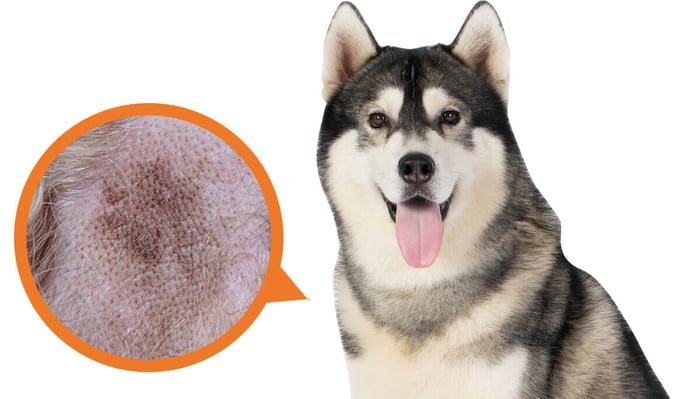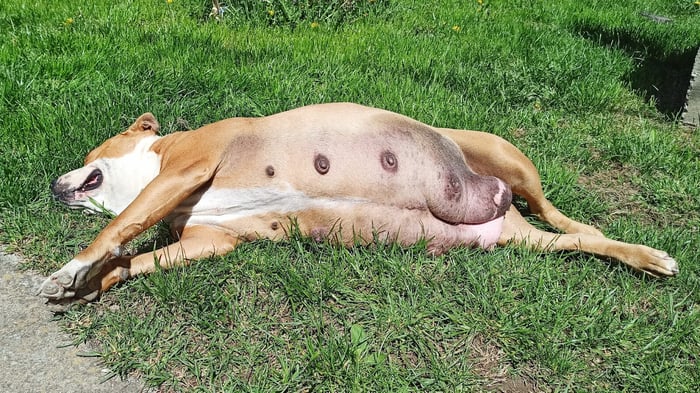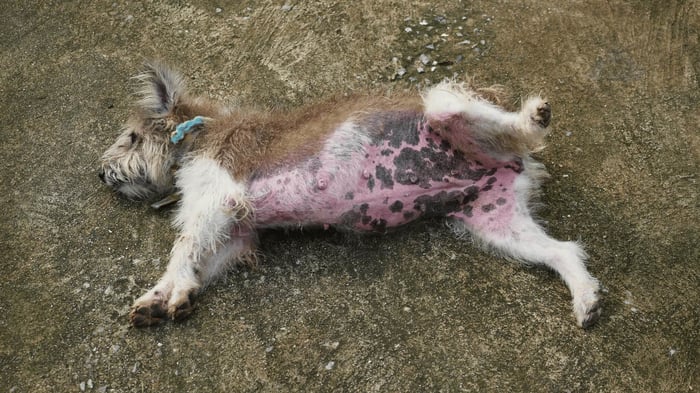If you’ve ever examined your dog’s skin under their fur, you likely found a few brown spots. Usually, dark spots or patches are no more than a dog’s natural skin color, like freckles or birthmarks.
Still, even though it can be natural, it’s vital to examine your dog’s skin regularly. It’s good practice to use bath time for this. While scrubbing your dog down with a gentle dog wash, look for changes in skin color or texture.
It’s important to be aware of pigment changes. After all, dark spots also can often mean skin problems like infections, irritation, or even a sign of a serious disease.
To deal with the issue, we’ve consulted the Clinical Atlas of Canine And Feline Dermatology to look at the most common reason for dark or brown patches. So let’s discuss the possible causes for brown spots on dog skin, when it’s normal, and when to see the vet.
Why Is My Dog Getting Brown Spots?
Brown spots on the skin of dogs with spotted coats are normal. But spots also occur because of age and sun exposure. Parasites, yeast, bacterial infections, and underlying disorders like cancer, Cushing’s, or Addison’s disease may also create brown spots or hyperpigmentation on the skin.
Let’s review the 12 major causes of dogs’ brown spots, freckles, and skin discoloration.
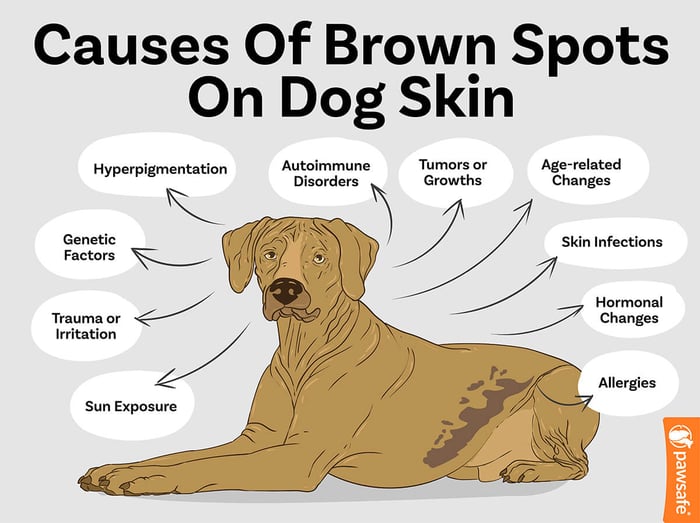
12 Causes of Brown Spots on Dog Skin
1. Natural Breed “Freckles” or Dapples on Dogs
Genetics or natural skin pigmentation is the most common reason dogs have brown spots or patches on otherwise pink skin. These are just like freckles or birthmarks. They are just areas where the skin has more pigment than others.
You will see this most commonly in dog breeds with dapple or spotted coats. Breeds that have spotted, dapple, ticked, harlequin, or merle coats almost always have dark spots on their skin. This includes Dalmatians, English Setters, Australian Shepherds, Great Danes, Blue Tick Coonhounds, and many more.
But you will find natural brown spots on most dogs with light skin anywhere on their body. You may even find spots on your dog’s tongue.
Surprisingly few dogs are one solid color all over their body. Even dogs almost completely black or brown may have white on their belly, chest, paws, or elsewhere. Wherever dogs have lighter pigment, dogs often have dark spots or patches.
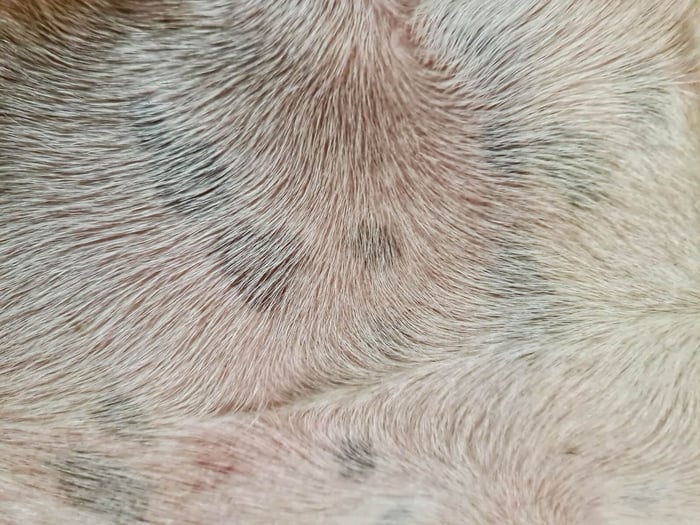
2. Hyperpigmentation on Dogs
When dog skin is irritated and inflamed for a prolonged period, it often develops brown spots or hyperpigmentation. Hyperpigmentation is a common symptom in one or multiple areas of a dog’s body. Technically, it refers to a massive increase in melanin in the skin (melanoderma) or the hair (melanotrichia).
Technically, this means dog skin with dark, brown, reddish-brown, or black spots around the problem area. But it usually also involves a change in the skin’s texture. The skin also thickens and becomes rougher or sometimes velvety. This is called lichenification.
Melanin often increases in areas surrounding inflamed skin, often from bacterial or fungal infections, like ringworm. It also happens after parasitic infestations like scabies or because of underlying health issues.
We will discuss each of these below. But perhaps the most common hyperpigmentation is the leathery calluses you will see on pressure points, like the elbows, in large dogs. These are usually large, dark, and hairless, but they typically have a ton of ingrown hairs.
Another common reason for hyperpigmentation is chafing or friction. Always check that your harness fits well, and look for areas where your dog’s skin may chafe. This includes their armpits or skin folds.
3. Brown Spots on Dog Skin are Often Age Spots
Brown and dark spots often appear on dogs as they age. Age spots usually show up on the ears, belly, and nose, depending on how much fur your dog has. Hairless breeds are prone to age spots all over their body.
It would be best if you kept an eye on age spots in case they start to change in shape, size, or texture. But usually, they are where the skin has built up a bit more melanin, just like pale-skinned humans.
Note that dark-skinned dogs may also get age spots, but it will be harder to see.
4. Sun Spots can Cause Freckles on Dogs
Of course, sun exposure often causes age spots in dogs. Still, they aren’t quite the same thing. Even young dogs can get spots from the sun. Dogs with pink skin and minimal fur are extremely vulnerable to sunburn and need daily sunscreen, just like people who are prone to sunburn.
However, even the most diligent owner of a white dog will forget that their dogs may love to sunbathe in winter when the sun does the most damage. White or pale dogs may get dark spots on their belly, lips, ears, or other exposed areas over time. These need to be monitored in case they turn into skin cancer.
5. Allergies and Spots on the Skin
Dog skin color under fur often changes with skin allergies. Dogs may get contact dermatitis, where their skin becomes itchy and irritated from contact with a material they are allergic to, such as a certain collar or a flea bite. They can also get environmental allergies to things like pollen or dust mites.
Food allergies to ingredients in dog food or treat also create itchy, irritated skin. Remember to get your dog tested for allergies, as the most common allergies are usually to proteins like chicken, beef, or soy. So a hypoallergenic diet depends entirely on what your dog is allergic to, and there is no such thing as a single hypoallergenic diet for all dogs.
Constant scratching can damage the skin, causing secondary infections that can cause brown spots. The inflammation can also lead to leathery brown or black spots of hyperpigmentation.
6. Fungal Infections
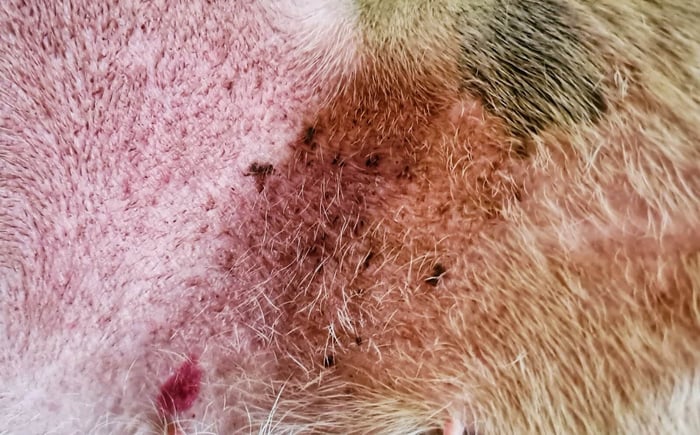
Yeast infections are one of the most common reasons for brown spots on dog skin. You may not notice it in the early stages as it can look like flea dirt. But if you’re googling “brown spots on dogs belly looks like dirt,” suspect a yeast infection.
Yeast infections often start as little black, brown, or reddish-brown specs on the belly, genitals, or under the armpits. It usually then develops into large patches of a reddish-brown rash. You may also struggle with folliculitis (inflamed hair follicles).
7. Bacterial Infections
Brown spots can also be from various bacterial infections that all fall under the term “pyoderma.” Pyoderma includes skin fold infections, puppy impetigo, and hot spots. All types of pyoderma will cause skin discoloration (usually red but also hyperpigmentation and dark spots), and they’ll have other symptoms like black scabs.
The most common pyoderma is a staph infection. Canine staph infections often look hard red bumps (folliculitis) or are filled with pus, like pimples. Around the chin, this is dog chin acne.
But it can also make a round area with hair loss. There should be a red, brown, or black spot (usually an open lesion or a scab) in the middle and a crusty edge.
8. Parasites
Another common cause of dark spots is parasites. Whether is flea dirt or bites, or scabs and marks from tick bites, you can expect to find some spots on your dog’s skin. Also, be sure to check your dog for mites, as these also cause hyperpigmentation.
9. Cancer
Any abnormal pigments or growths like dog skin tags always need to be closely watched. Just as the sun and aging can cause spots on the skin, it can also cause melanomas.
Dogs have different kinds of skin cancer, so look out for raised warts, sores, or scabs that never heal, odd lumps, and any changes in pigment, like black spots.
10. Medications
Hyperpigmentation in dogs can also happen with various medications. Notably;
- Mitotane;
- Cabergoline;
- Ketoconasole; and
- Minocycline.
11. Underlying Hormonal or Immune Conditions
Several serious conditions affect a dog’s skin and can cause brown spots. These are usually to do with the immune or the endocrine (hormonal) system.
Firstly, if you see any major changes in your dog’s skin, always go for a check-up and ask for blood work. Check your dog for hypothyroidism and diabetes.
Another major cause of brown spots on the skin is thyroid problems. This could be either hypoadrenocorticism (Addison’s disease), which often has hyperpigmentation and is often overlooked. It is rare but more common in young female dogs. So if you notice dark spots on a dog’s skin with hair loss, particularly in a female, always check adrenal gland function.
The opposite of Addison’s, hyperadrenocorticism or Cushing’s disease, also often has skin discoloration and other skin problems. So be sure to test for both.
Autoimmune problems like Lupus can also cause dogs to lose pigment around their nose.
12. Vitiligo
Rarely, dogs may get vitiligo, where they lose pigment. Usually, this is the only in one area, the nose, typically called “snow nose.” But it can also happen across the skin, where the dog loses patches of pigment, leaving a network of brown or dark spots behind.
Sometimes this happens because of genetics, but other times when an autoimmune disease attacks the cells that produce pigment.
Final Thoughts
Brown spots on dog skin can occur naturally or develop as the dog ages. Sun exposure can increase the rate of dark spots, but typically it happens because of hyperpigmentation from irritated and inflamed skin. The reasons for this are usually infections, parasites, or underlying disorders like immune and hormonal problems.
If brown spots change size or texture, or come with other symptoms like skin issues or lethargy, see your vet for a check-up.


